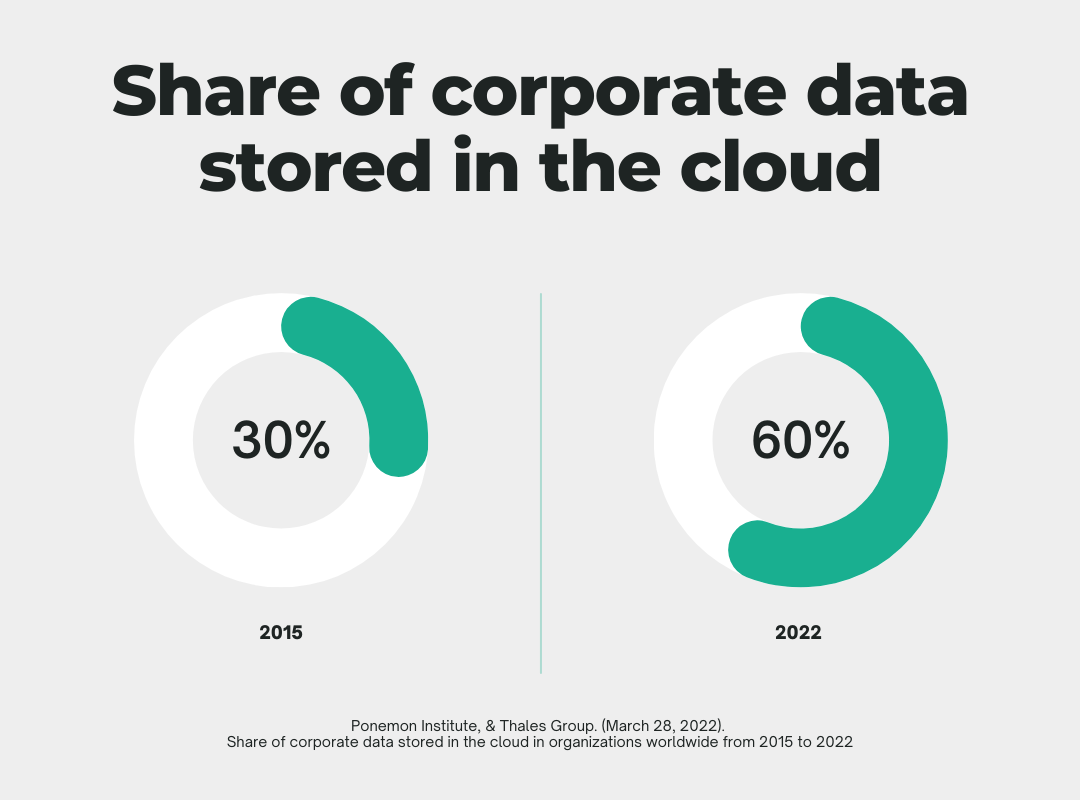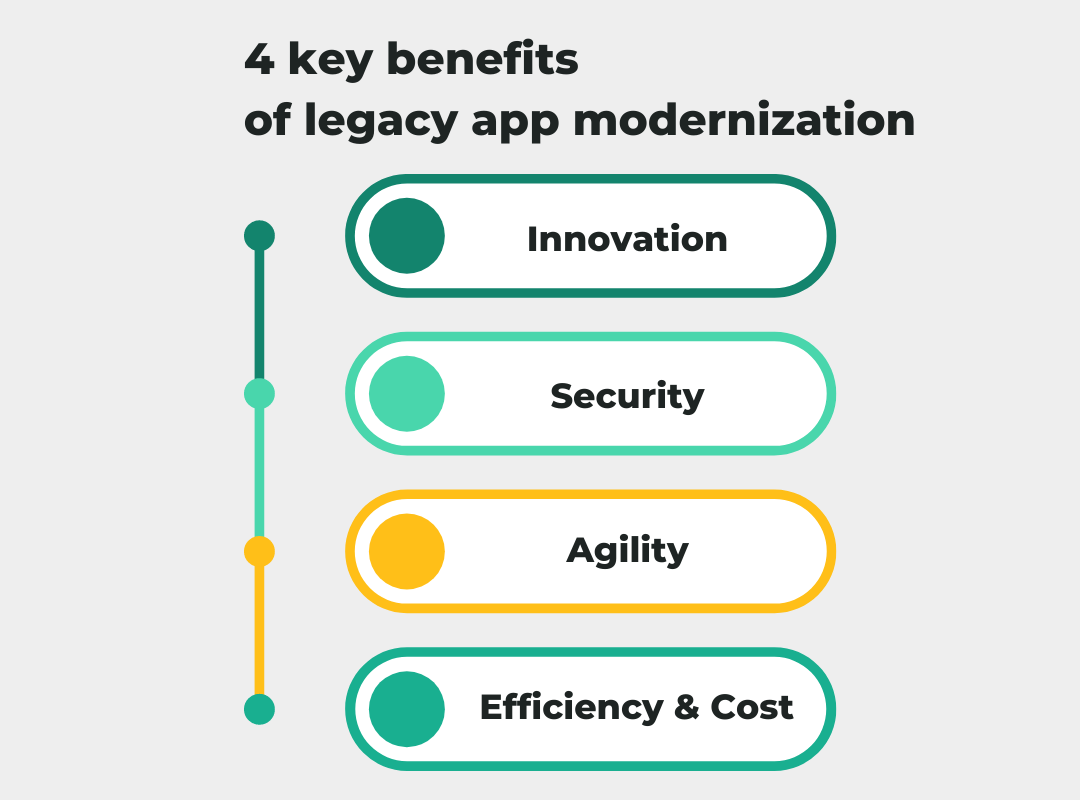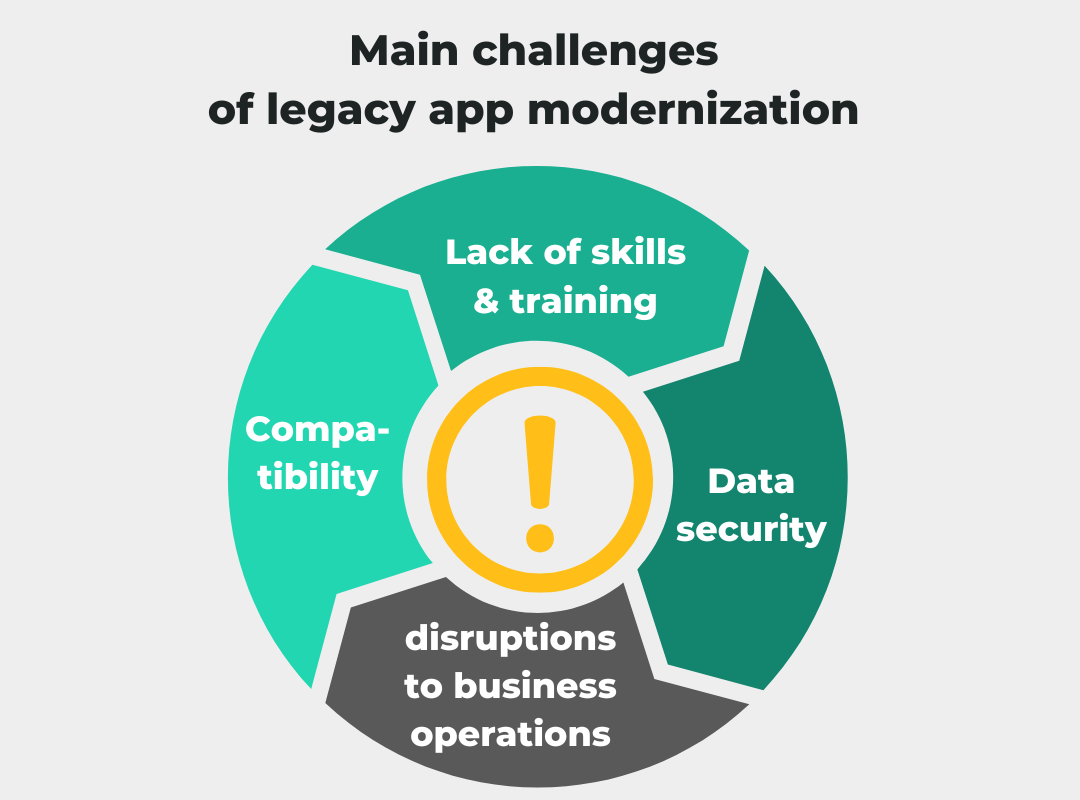Modernizing legacy IT applications

Over the past decade, the adoption of cloud computing by companies all over the world has skyrocketed, with the share of corporate data stored in the cloud doubling from 30% in 2015 to already 60% in 2022, according to Statista. Why is that? Many companies find themselves with a large set of legacy applications, that are outdated and require costly investments. CIOs are under pressure to keep their IT landscape up to date - to achieve goals like operational efficiency, enhanced security, and superior customer experiences. Fundamental cloud modernization technologies are containerization, micro services or orchestration and automation solutions.
This article will cover the reasons for legacy application modernization, how to define a strategy to do it, specific modernization aspects of selected services, main challenges and how companies commonly address them.
 Corporate cloud usage for data storage has doubled in the last 7 years.
Corporate cloud usage for data storage has doubled in the last 7 years.
Why modernize IT applications using cloud services?
The most obvious answer is: because of legacy IT’s shortcomings. So, what we consider “traditional”, on-premise IT infrastructure has various limitations - in terms of scalability, agility, cost-effectiveness, and predictability (sudden heavy investments in hardware or maintenance can become necessary). Instead, by shifting your IT to the cloud, you “outsource” all on-premise-related challenges (we say “challenges”, but we mean “problems”) to private or public cloud providers.
Top 4 benefits of modernizing legacy applications
Here’s a list of our top 4 benefits of modernizing legacy applications using cloud services:
-
Faster to innovate & faster to market: Stop managing servers and buildings, and instead, focus on what your business is best at: innovation. Streamline the development process, reduce time-to-market and create competitive advantage for the organization.
-
Security: Enjoy the robust security and reliability that comes with automatic updates, built-in safeguards, and automated tasks of cloud-first applications (allowing for high availability, disaster recovery, backups, and performance monitoring).
-
Agility: Stay agile and compatible with evolving technology to meet both current and future business needs. Automatically up- or down-scale depending on current demand.
-
Efficiency & Cost: Improve efficiency and streamline processes without disrupting operations. This approach builds on existing investments, ensuring business continuity and reducing total cost of ownership.
 The main 4 benefits of modernizing legacy applications are innovation, security, agility and efficiency.
The main 4 benefits of modernizing legacy applications are innovation, security, agility and efficiency.
Legacy system modernization strategies
The application modernization strategy is a plan for updating and optimizing legacy applications by migrating them to cloud-based platforms. Your modernization strategy can be developed following these 8 steps:
- Define modernization goals: Defining which central goals you want to achieve by implementing cloud-based services
- Financial planning: Properly planning the allocation of budgets for pre-migration, migration, and post-migration phases
- Data collection: Understanding the legacy IT you’re dealing with and map all your existing applications
- Application assessment: Assess the existing applications from a technology and business perspective to decide on business criticality, cloud readiness, potential modernization benefits, and risks (security, sensitive data, compliance…)
- Selection of 6R strategies: Defining the best modernization strategy for each application, based on the 6R framework (rehost, refactor, repurchase etc.)
- Target architecture generation: Selecting the cloud services that fit your goals the best (IaaS, PaaS, SaaS, preferred cloud service providers etc.)
- The actual cloud migration: Migrating or replacing all applications with their respective cloud-based solution
- Continuous monitoring: Keeping an eye on your IT infrastructure to spot upcoming needs and application changes early on
How to modernize mainframes, leverage industry cloud platforms and more
Enough with the general benefits and steps of modernizing legacy apps: let’s jump into some details. Of course, this article doesn’t know which challenges you and your company or client are facing right now, but we can list a couple of application modernization candidates we’ve noticed in our current projects: mainframes, in-house built custom web solutions and industry specific solutions. In this section, we’ll discuss in more detail what we think are the most relevant modernization approaches for these types of applications, and which cloud services could be best-suited.
Mainframes modernization
A mainframe is a powerful computer designed to manage large-scale and critical applications for organizations. Mainframes can be very cost intensive regarding hardware, but also software and overall maintenance. For this reason many companies start shifting mainframe applications to cloud.
Due to the nature of applications that are developed and run on mainframe systems, even a lift-and-shift approach cannot be directly applied. Furthermore, the goal of migrating to cloud away from mainframes usually originates in the demand of modernizing business critical legacy applications, due to increasing lack of skillset and decreasing ROI. The pace in which you want to migrate to cloud depends on your preferred migration strategy and you have both rehost/replatform as well a refactor choices:
- Rehost/replatform: major cloud service providers like AWS, GCP and Azure offer, for instance, Microfocus Enterprise Server to redeploy mainframe based software. (modernization example with Microfocus Enterprise server on AWS EC2. It offers a runtime platform for operating the mainframed based software on cloud virtual servers and even supports integration with cloud managed services like databases to get your modernization started.
- Refactor: in this case, you can either start greenfield (from scratch) and rebuild the application in a cloud native fashion. But you can also start from your existing infrastructure, and leverage tools for code emulation and conversion. Such tools are e.g. offered by AWS with its Blueage mainframe migration services but also from various transformation partners like Deloitte's innoWake.
In-house, web-based applications
Many in-house built web based solutions use standard software stacks (e.g. Java, Python or Node.js based leveraging some relational database engine). They can be easily run on application platform services like AWS Elastic Beanstalk, Google Cloud's App Engine or Azure App Service, which improves deployment efficiency and lowers maintenance. In this approach the cloud platform builds a maintenance free layer to run your applications, whether they are built as monoliths or microservices and allow both for vertical and horizontal scaling on demand. Related to this approach is using simple container runtime platforms like Google Cloud's CloudRun.
Business applications
On many occasions we have seen "business applications" that are merely built off Excel spreadsheets or a customized relational database system. These are intended to collect and hold data and perform some number crunching and reporting for added intelligence in a certain business domain. As data sharing, traceability of changes, security and availability are usually hard to achieve, these applications should be migrated to analytics platforms or data warehouses as offered by your favorite cloud service provider.
In order to get rid of your legacy BI application, consider e.g. using Google Cloud Big Query, AWS Redshift or an Azure Synapse Analytics, Microsoft Power BI based solution. Those solutions offer all characteristics of production grade software, are able to store incredible amounts of data and scale well.
Industry specific solutions
Finally, a topic we more and more discuss with clients and cloud partners alike is replacing custom industry specific solutions with cloud operated ones for added platform standardization, agility and lowered maintenance efforts. Industry specific cloud solutions will play a more and more prominent role in the future, e.g. in gaming, banking, in producing and industrial companies and beyond. You can have a look, for instance, at AWS categorization of industry specific cloud solutions or Google Cloud's partnerships with next-generation banking systems.
Main challenges when modernizing your IT & how to address them
We now understood, that modernizing legacy applications with cloud services can offer many benefits to organizations (scalability, flexibility, cost-effectiveness etc.). But of course, it’s not all rainbows and candy (we wish!): the modernization process is full of challenges:
 The main 4 challenges when modernizing legacy applications are lack of skills, data security, business disruptions and compatibility issues.
The main 4 challenges when modernizing legacy applications are lack of skills, data security, business disruptions and compatibility issues.
- One common challenge is ensuring that current staff has the necessary skills to implement and manage cloud-based applications. Alternatively, hiring new employees with the required expertise can also be an option.
- Legacy applications that may not be compatible with cloud services also present a challenge, and in some cases, may require a complete rebuild.
- Data security and compliance requirements must also be addressed, as they are of great importance when transitioning to the cloud.
- Finally, potential disruptions to business operations during migration must be taken into account, and plans should be in place to minimize their impact.
Addressing modernization issues of legacy applications
So, what can you do about the challenges listed above? Luckily, you’re not the first one facing these issues and there’s a handful of things you can do to ease the modernization process:
- Train and upskill your current staff to work with cloud-based applications and manage the transition
- Get professional help: Modernizing is hard but you don’t have to do it alone! Vendors or third-party service providers are specialized in migrating legacy applications to the cloud or rebuilding them entirely. This can help ensure compatibility, reduce disruption to business operations and take weight off your staffs’ shoulders.
- Implement robust data security and compliance measures, e.g. encryption or access controls, to protect critical information.
- Properly assess and plan in advance: Create a detailed migration plan that outlines potential risks and contingency measures to minimize disruptions to business operations during the transition to cloud-based applications.
Conclusion: Modernizing legacy IT systems
You’ve read a lot about modernization strategies, challenges and benefits. So, let’s sum this up:
- 💪 Modernizing legacy applications with cloud services comes with many benefits, such as scalability, agility, cost-effectiveness, or enhanced security.
- ❌ You’ll face different challenges, such as staff skills, compatibility issues or data security.
- ✅ Address them by training and upskilling, professional help, robust data security measures, and proper assessment and planning.
❤️ IT modernization allows businesses to focus on their core competencies, streamline processes, and maintain business continuity while meeting current and future needs.
If this sounds like a lot, that’s because it is a lot. But you don’t have to joggle it all by yourself. Our software platform Txture walks you through all the steps of a legacy IT modernization, from data collection to target architecture generation and continuous monitoring afterwards.
How does it look when you use Txture for legacy system modernization? Check out this short overview video:
Or talk directly to sales to discuss your organization’s case:
Related posts
14.11.2023Cloud MigrationSecurity risks of cloud computing30.3.2023
Cloud Migration Cloud Migration Overview | The 4 Phases & Best Practices6.12.2022
Cloud Target ArchitectureCloud Transformation: how to define the right cloud solution architecture16.11.2022
Cloud AssessmentReady, set, cloud: What is a cloud readiness assessment?2.11.2022
Cloud KnowledgeFaces of Cloud Transformation
